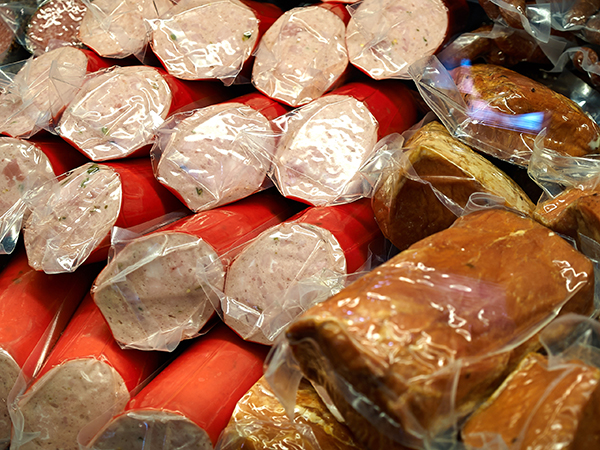Using Raman Spectroscopy to Evaluate Laminated Food Packaging Films

Laminated plastics are common and popular food packaging options. They are strong and flexible, making them ideal for both packing and presentation, and can be used for cooking, frozen foods, drink pouches, snack products and even pet food. Yet, unreliable plastics can create a problem for food packaging and the safety of a product.
If a grade of plastic is not what was promised or needed, there can be issues that lead to spoilage, spills and messes, crystallization, mold or other risks. Additionally, there may be concerns about how laminated films will interact with the product itself, as it could impact food safety or lifecycle. For these reasons, it is critical to have accurate information when evaluating the plastics films used in food packaging.
Raman Spectroscopy
Raman spectroscopy (RS) is a powerful method of identifying and characterizing chemical compounds based on light scattering by a sample. It can be used to identify layers in food packaging films to accurately understand the chemical makeup of the laminated plastic. The effect is named for its inventor, C.V. Raman, who was awarded the Nobel prize in physics for its discovery in 1930. It is a non-destructive method that uses an induced-dipole mechanism to probe the vibrations of the chemical bonds in a molecule. The Raman spectrum shows a pattern of molecular vibrations that represents a detailed chemical fingerprint of a material, providing insights into the product composition.
A Raman spectrum is obtained by illuminating the sample with a laser and collecting and measuring the scattered light with a spectrometer. The molecular vibrational modes vary depending on the geometry and electronic structure of the chemical compound present in the sample. By controlling the position of the laser focus point on a sample, a map of the composition can be created. This provides valuable information on the plastic film related to its composition, such as number of layers, thickness of each layer and overall make-up.
In the food packaging and safety industry, this technique can be used to evaluate laminated plastic films by examining polymers, minerals, and/or inorganic fillers and pigments present in the film. Specific food packaging products that can benefit from RS assessments include heat seals, containers, lids, films and wrappers both for durability and performance and for diffusion, permeation or other concerns.
Benefits and Limitations
There are numerous benefits to using the RS method. A major advantage is that there is virtually no sample preparation necessary; spectra can be obtained without direct contact, such as through the sides of glass vials or through windows in reaction cells. As a non-destructive technique, it allows an easy, highly accurate way to take a sample, create a chemical composition map and better understand films’ barrier properties, structural integrity and layers. It has broad applicability and works using conventional microscope optics.
There are, of course, limitations to the approach, as well. Fluorescent components or impurities in a sample can emit a photoluminescent background that overwhelms the Raman scattering. Samples can also be damaged by the laser if too much power is used, or the sample absorbs light at the laser wavelength. Samples that do fluoresce and samples that are photolabile act as common interferences for the RS method. In many cases, these interferences can be overcome with the proper choice of laser and sampling techniques. Additionally, while RS provides an accurate analysis of laminated films, the technique cannot be used on metals or metallic compounds (which can be assessed using scanning electron microscopy or light optical microscopy) or organic pigments or ink layers (which can be assessed with other infrared techniques).
Using RS for Food Packaging
RS can offer a variety of insights for food packaging films:
- Failure analysis. If a plastic used for a heat seal in a fruit or yogurt cup fails, it could result in a mess for manufacturers, stores or the consumer. Exposure to air or elements could also lead to spoilage, particularly for refrigerated foods. Inconsistent plastic packaging could result in weak points that break, crack or puncture, which could also result in mold, mess or other spoilage concerns. If a manufacturer experiences a failure in a heat seal or packaging leading to leakage or spoilage, RS analysis can help determine why the failure occurred (was in the plastic film or something else) to help prevent future issues.
- Supply chain validation. It is extremely important that the plastic films coming from suppliers are what they are promising and what the manufacturer needs. RS analysis can be used to determine the chemical make-up and morphology of packaging to confirm a supplier’s claims before proceeding with use of the film in food packaging and products.
- Simple decision making. If a manufacturer is trying to decide which material to use, RS can provide answers. For example, if there is a need for moisture non-permeating films and there are multiple options available, an RS chemical map can illustrate what to expect with each option, aiding in the decision-making process when combined with other known factors such as cost or timing. If there is an additive in the food product that may diffuse into the film, RS can determine which material might best resist the potential problem.
- Packaging appearance. If there is a swirl or haze in the packaging, RS can compare the area with the issue to a clear section to determine if the defect in the film is a foreign polymer or an inorganic pigment or filler, identifying the source of the problem.
RS analysis provides a wealth of information in a manner that is non-destructive. Giving a chemical fingerprint to identify composition with extremely good spatial resolution gives manufacturers valuable information that can be used to mitigate issues, correct problems or make important decisions. These actions in turn can help ensure food safety, which builds brand image and manufacturer equity. Ultimately, RS analysis can play an important role in the success of a product, a brand or a company.